ALREADY A PAID SUBSCRIBER? SIGN IN
ALREADY A PAID SUBSCRIBER? SIGN IN
ALREADY A PAID SUBSCRIBER? SIGN IN
ALREADY A PAID SUBSCRIBER? SIGN IN
ALREADY A PAID SUBSCRIBER? SIGN IN
ALREADY A PAID SUBSCRIBER? SIGN IN
ALREADY A PAID SUBSCRIBER? SIGN IN
Life is stirring. The hazel streaming with catkin, reflected now in the stillness of the pond. The Cornus mas that I’ve staggered down the ditch are hinting at what is to come. The first flowers that you have to find amongst the branches, open a dark rich yellow. In a fortnight when they are at their peak the trees will glow gently against the backdrop of dormancy still around them. A million tiny flowers contributing to a whole. A shimmer of new life that is happy to run with whichever way February decides to go.
At ground level there is an awakening of celandines and on the warmest banks, primrose and violets. The galanthus are entering their fortnight of peak snowdrop and bolstering me in my annual efforts to extend their reach. The more there are, the further I want them to travel and as soon as their flowers dim, I will spend a couple of Sundays splitting the biggest clumps and replanting them so that the trail continues. To run along the banks of the stream and pool in eddies in the clearings and to line the lane that our fields dip into on our boundaries.

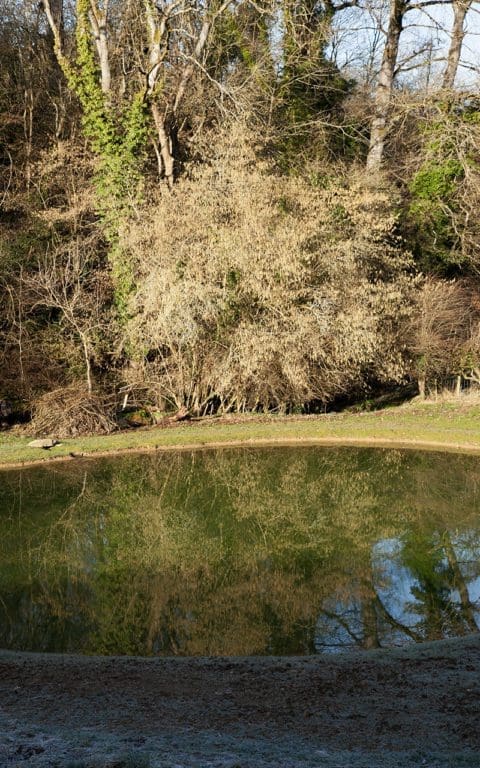
There is joy in the tide slowly turning and, as the garden has evolved, it has become clear that I need to provide for more early risers. To date, spring bulbs and early perennials have been confined to the skirts of the trees and shrubs that punctuate the perennial garden. These areas are cleared in early January whilst the new nibs of growth are still below ground and before they begin to stir, so that they can emerge uninterrupted. The open spaces, which are planted as much for the growing season as for the beauty of the winter skeletons, have a later rhythm and are left standing until the second half of February. Life is made easier in these areas for not having to tread between plants that are on an early growth cycle.
Though it would be nice to have both and a layering of the two, I have to be practical with my time. So, as part of the evolution of this place, it is time to commit to a more generous area where I can enjoy the early risers. Cardamine quinquefolia and wood anemone and drifts of hellebores and first bulbs. A planting that operates on a different timescale, with an early start that dims once the main garden picks up. Somewhere that can be cleared and ready ahead of the areas where I am still enjoying the skeletons.
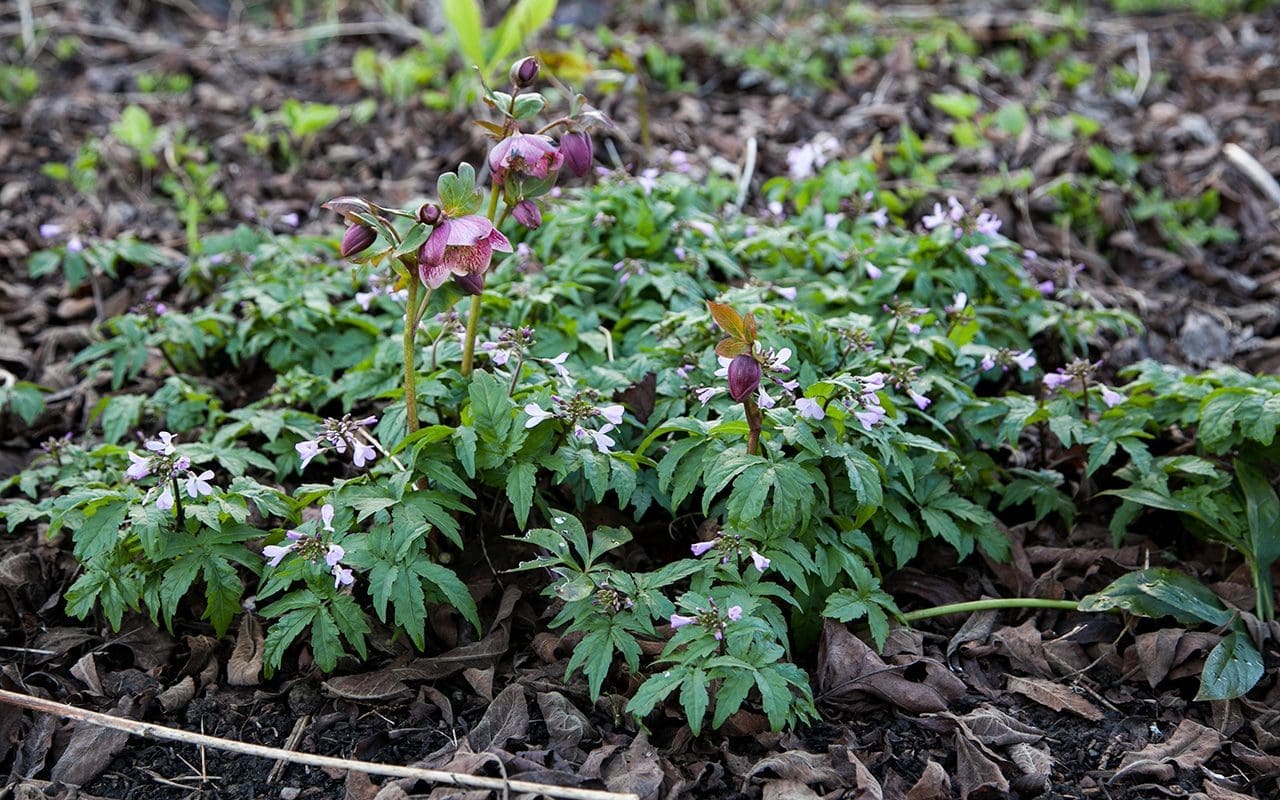
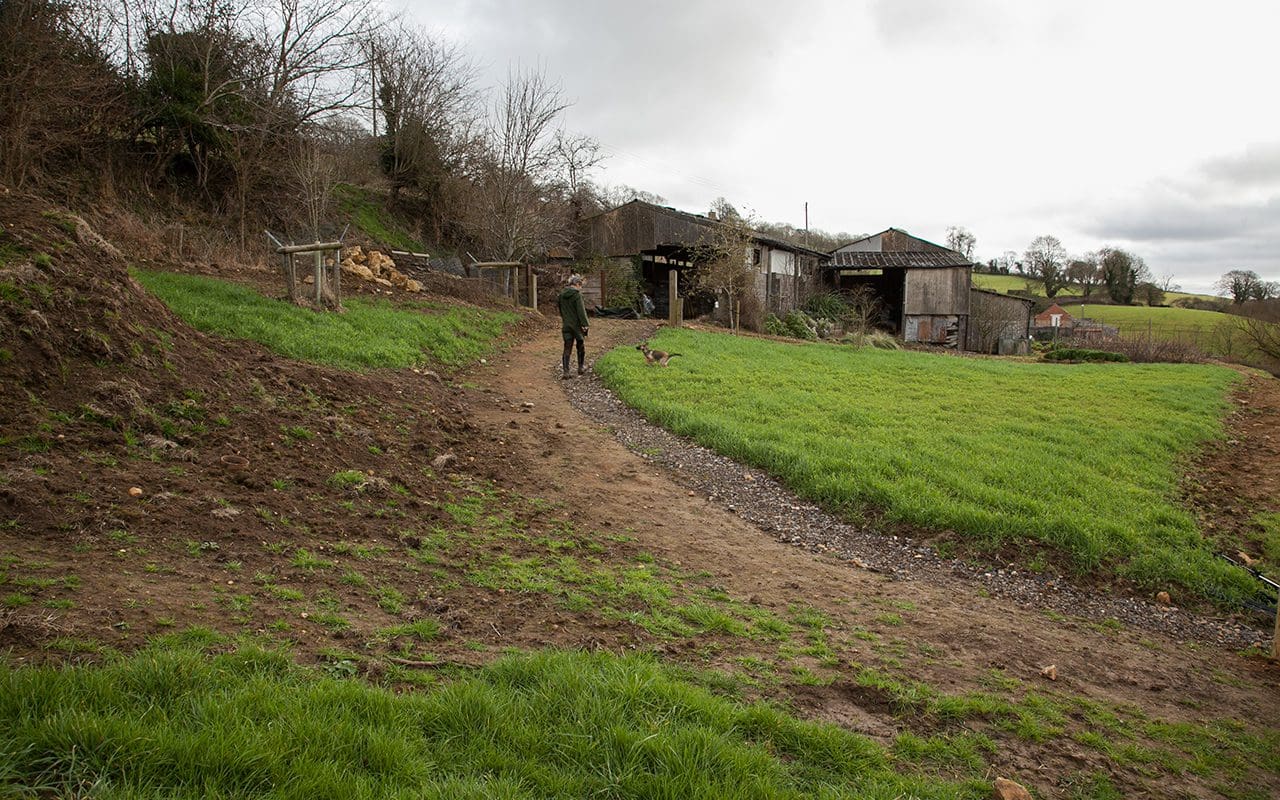
Making the pond last summer precipitated this opportunity, one creative action leading neatly to opening up another. The hole we made in the ground to provide us with a water body created a considerable pile of subsoil that had to be found a home. This was trundled up the hill where it was regraded into a new landform, extending the level we made around the barns for the kitchen garden. A curving grade to the front was massaged into the existing banks and oversown last September with a perennial wildflower mix to bind the slopes. The carefully saved topsoil from the pond was redistributed over the new plateau and sown with a winter rye and vetch green manure crop to protect the soil over the winter. In March we will rotovate this in and the new ground will be sown with annuals to allow me the time to get used to the space and mull over my next moves.
Above the new plateau, the ground rises up to meet the wild hedgerow I’ve let grow out to provide us with a bat and owl corridor above it and it is on this slope that I will make a new woodland garden. A gentle shade will be cast by a grove of Snowy Mespilus that will connect the eye to the plum orchard beyond and the underplanting will aim to provide us with an early spring garden. A garden with a different rhythm, somewhere to tidy first and enjoy whilst the rest of the garden is yet to think about coming to life. Somewhere for now and somewhere, once spring passes, that can be allowed to simply drop back into shadow like the hazel that are currently holding our attention.
Words: Dan Pearson | Photographs: Huw Morgan
Published 12 February 2022
Once upon a time I had a very sweet tooth. Each Christmas Eve, close to midnight, as my overexcited brother and I lay feigning sleep in our bunk beds, dad would come and lay something heavy at our feet. We knew exactly what it was, and it called on all our reserves of self-control and superstition to prevent ourselves from peeking until it started to get light. When we did – and my younger brother was always the first to crack – we would haul the stockings (actually dad’s nylon football socks) up the bed and start to unpack them. Always alongside this stocking was another made of net. A Cadbury’s Christmas selection pack containing the usual suspects – Mars Bars, Twix, Milky Way, Marathon. We would slowly eat our way through these on Christmas morning and still somehow have room for lunch.
As a child I was always more interested in what was for ‘afters’ than the main event and my favourites usually involved chocolate, whether it was Bird’s Angel Delight, mini rolls, steamed chocolate pudding, Viennetta ice cream or choc ices. At around the age of 9 I started baking my way through the Marguerite Patten recipe cards mum had collected and which sat in a specially made plastic box on top of the fridge freezer. Once I had become proficient with scones, jam tarts and sponges, I quickly moved on to Devil’s Food Cake, chocolate Swiss Roll, Black Forest Gateau and, eventually, eclairs and profiteroles. My pièce de résistance, however, was Marguerite’s Pots au Chocolat, which to me looked impossibly chic in the photo on the front of the card. The dark, velvet mousse in simple, white porcelain pots, decorated with elegant quills of dark chocolate. It made me feel very grown up the first time I served them. Looking back for that recipe now I find that they contained melted marshmallows. Certainly not the purist’s idea of this classic French dessert, but one that, as a child, I was more than happy to accommodate.
As the years passed my palate became more refined. I graduated from Cadbury’s Dairy Milk to Bournville, from milk to dark chocolate Bounty bars and got a taste for Fry’s Chocolate Creams from my dad. (Mint, since you ask.) At university, I discovered Swiss and Belgian chocolate before, in my mid ‘20’s, experiencing a revelation. I had moved into a house on Bonnington Square in Vauxhall and, unbeknownst to me, my new landlady was about to change my view of chocolate forever. She was Chantal Coady who, in 1983, had opened Rococo Chocolates on the King’s Road. There were four of us renting rooms there and every month Chantal would bring home a box of ‘bin ends’, broken bars and trial new products from the shop and invite us for a chocolate tasting.
This may conjure images of a craven orgy of chocolate bingeing, but quite the contrary. The room was candle lit, a fine cloth on the dining table and a small selection of wines and spirits were available to be sipped in recommended partnerships with some of the ‘sweets’. Chantal would break small pieces of chocolate onto plates and pass them round. We were instructed to place the chocolate on our tongues and to allow it to melt slowly – no chewing! – and to describe the flavours we were tasting. Chantal explained how fake vanilla, hydrogenated oils and sugar destroyed the true nature of chocolate and would get us to compare my childhood Dairy Milk to a high cocoa content milk chocolate to understand what she meant. She taught us to appreciate it like fine wine and I have never looked back.
Christmas always calls for chocolate, but as I have aged my taste for sweet things has tempered and I have decreased the amount of refined sugar I eat. I rarely order pudding in restaurants these days unless I am prepared both for the initial sugar rush and the almost immediate headachy comedown. At home, dessert usually takes the form of stewed fruit or a handful of figs or dates, rather than anything sweeter. But it’s Christmas and I want chocolate, so I worked on this dessert recipe without refined sugar.
The combination of pumpkin and dates in the filling means that it needs no further sweetening, although if using chocolate with more than 82% cocoa solids you might want to and add honey or another sweetener to taste. If possible, use a drier-fleshed variety of pumpkin, otherwise you may need to drain the flesh before using as you don’t want the filling to be too wet. The Kabocha pumpkin I use has the texture and flavour of chestnuts, which makes it particularly truffle-like.
Chantal was also a pioneer in the use of unexpected flavourings and this tart is also the perfect foil for your favourites. To my knowledge, she was the first to make cardamom flavoured chocolate, to which she introduced me and which is my habitual choice. However, you can infuse the milk and cream with any winter spice or herb you like. Bay is very good (a couple of leaves), or try a sprig or two of rosemary or thyme, a spoonful of ground fennel seeds or even some crushed juniper berries. A teaspoon of finely ground espresso coffee heightens the bitterness. Half a teaspoon of chilli powder warms the mouth and accentuates the flavour of the chocolate, while a few drops of rose or rose geranium oil add a different level of perfumed refinement. The addition of a couple of tablespoons of alcohol – rum, for instance – makes it definitely adults only. Although we have been eating it plain this week, for a truly festive plate this would be particularly good with brandy-soaked prunes or figs or pears poached in red wine. Definitely a chocolate dessert for grown-ups, not children.
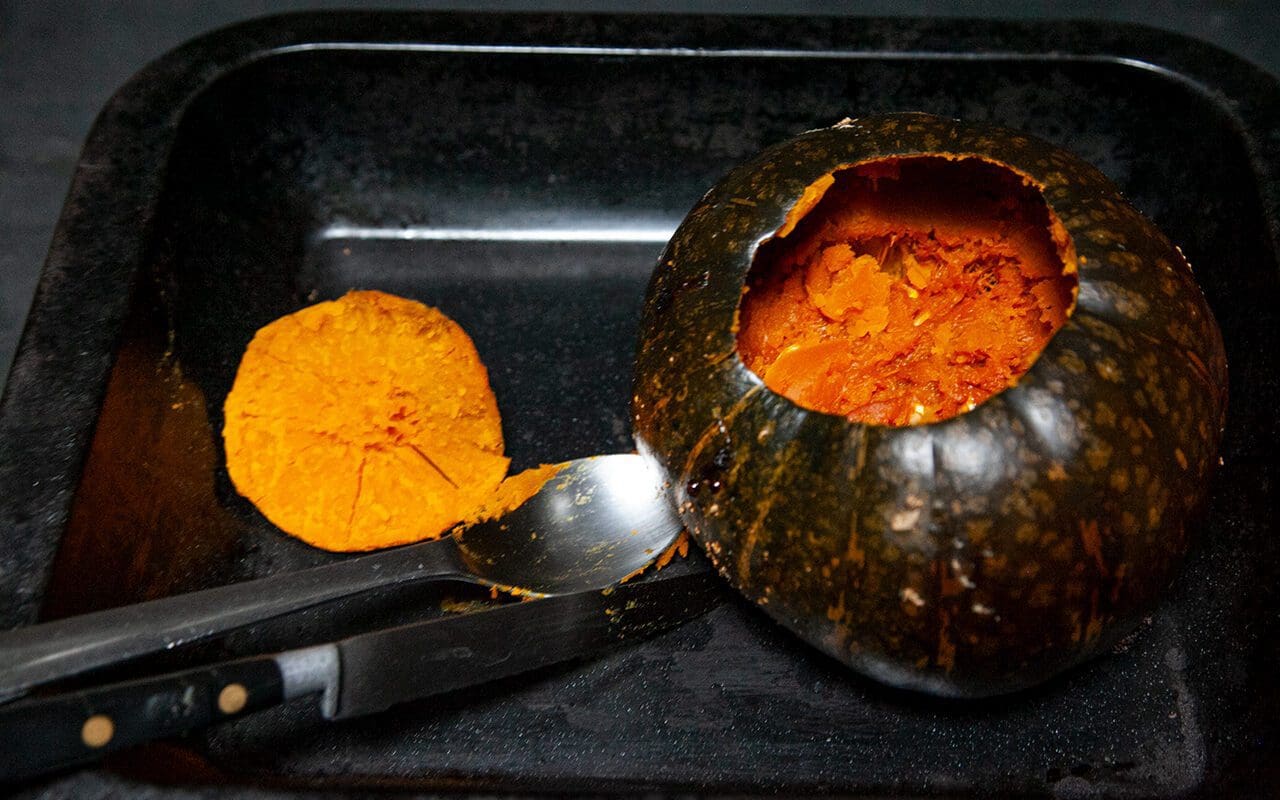
Serves 12
Pastry
75g hazelnuts
150g plain flour
1.5 tablespoons honey or maple syrup
75g cold butter
1 large egg, beaten
A pinch of salt
Filling
200g cooked pumpkin
100g dates
100ml milk
250ml double cream
3 large eggs
200g dark chocolate (minimum 70% cocoa solids)
Seeds from 3 cardamom pods, finely ground or other chosen flavouring
You will need a 23cm round, fluted tart tin with a removable base.
Set the oven to 180C.
Put the hazelnuts into a small baking pan and roast in the oven for 10 minutes until lightly toasted and fragrant. Remove and allow to cool, then put into a food processor and process into a medium-fine flour. Do not over process or you will end up with nut butter.
Add the flour to the hazelnuts and pulse mix. Cut the cold butter into 1cm cubes and add to the flour and nuts. Pulse again until the mixture resembles breadcrumbs. With the motor running slowly add the beaten egg and honey until the dough comes together. Stop the machine immediately and quickly remove the dough. It will be very soft. Form into a ball, wrap and put into the fridge for 30 minutes.
When the pastry has chilled, roll it out carefully on a floured surface until large enough to line the tart tin. The pastry is very short, so work quickly and carefully. However, if it falls apart just fit the pieces to the tin and press together gently to join. Remove any excess pastry from the rim, line with greaseproof paper and fill with baking beans. Bake blind for 20 minutes. Remove the baking beans and greaseproof paper and return to the oven for a further 5 minutes until it looks dry. Remove from the oven and allow to cool.
To make the filling heat the milk and cream in a small pan. Grind the cardamom seeds to a fine powder in a mortar and pestle and add to the milk. As soon as the milk comes to the boil remove from the heat, add the dates put a lid on the pan and leave to stand until cool.
Chop the chocolate coarsely and put into a heatproof bowl. Put into the oven for about 10 minutes until almost melted. Remove from the oven and then beat with a fork to ensure that all of the chocolate is melted.
Put the cooled dates and cream, eggs and pumpkin into the food processor and process until smooth. Add the chocolate and mix until fully combined. Pour the mixture into the prepared pastry case and bake for 35-45 minutes until the mixture just starts to crack at the edges, but still has a little wobble in the centre.
Leave to stand for 20 minutes before removing from the tin and transferring to a serving plate. Decorate with sieved icing sugar as you wish.
Serve warm.
This reheats and freezes well.
This can easily be made suitable for vegans, using coconut oil and sugar and no egg in the pastry. For the filling substitute the milk with vegetable milk, the cream with an equal weight of silken tofu (although do not heat this with the milk). Substitute the eggs with chia ‘eggs’ (1 tbsp ground chia seed mixed with 3 tbsp cold water for each egg).
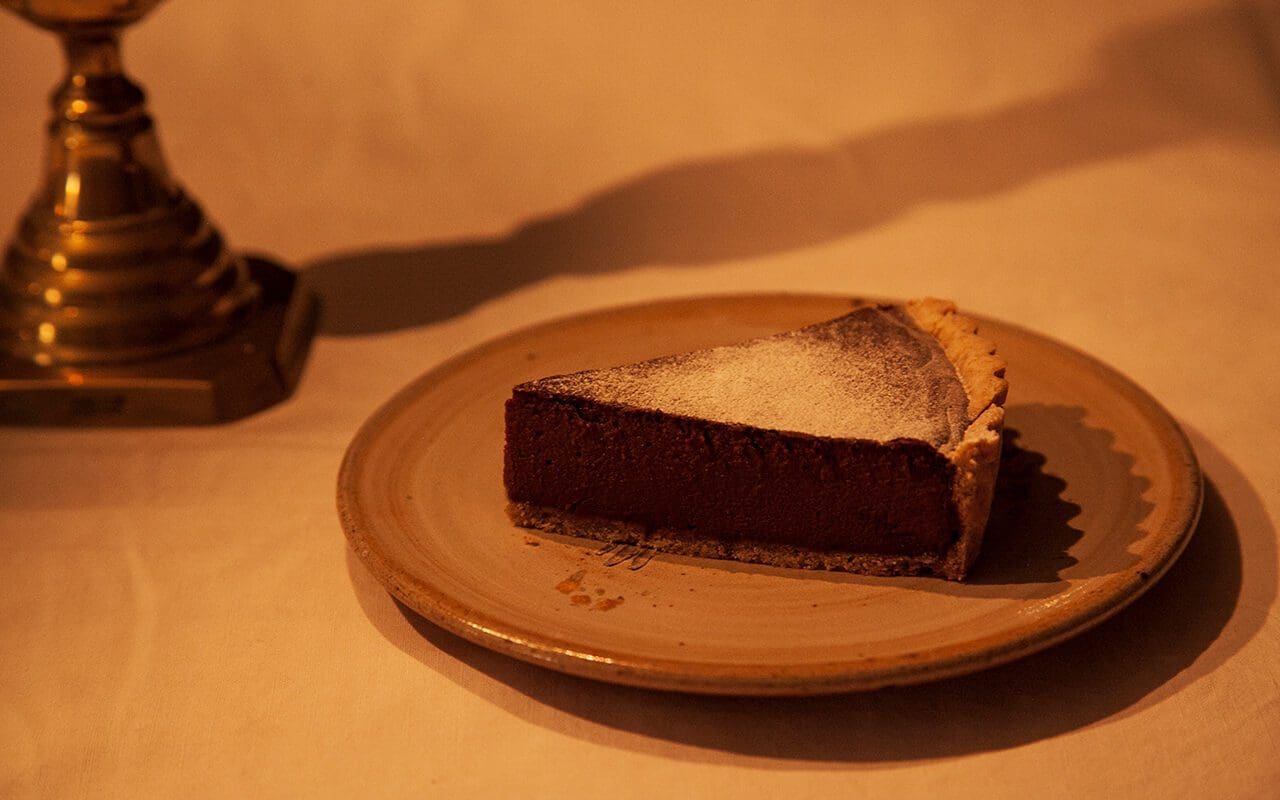
Recipe & photographs: Huw Morgan
Published 19 December 2020
The shift has happened. Last leaves down to reveal the trunks and tracery of branches. Winter outlines and the definition of reading individuals, their structures and differing characters against the sky. Hidden by the cloak of the growing season, but ever present, is the ivy. Where it grows uninterrupted and using the frame of another tree to make its way, a shadowy presence or a life within throws its winter outline. Dark and glossy and a refuge for the birds.
The oldest plants sit just inside the halo of their host, the growth becoming arborescent once it meets its reach. The mature ivy wood is entirely different from the juvenile, branching like antlers and without the need for the suckers that attach the young plant on its ascent. This wood, throws flowers in November, the very last forage for bees, and then goes on to weight itself with darkening, inky green berries. Fruits that at the very end of winter are ripe and ready for hungry birds. If you propagate the arborescent wood, the resulting plant retains this character and makes a fine winter evergreen if you grow it without the temptation of a support nearby. A wall or a trunk will trigger its innate desire to climb and conquer and it will revert to type if it senses an opportunity.
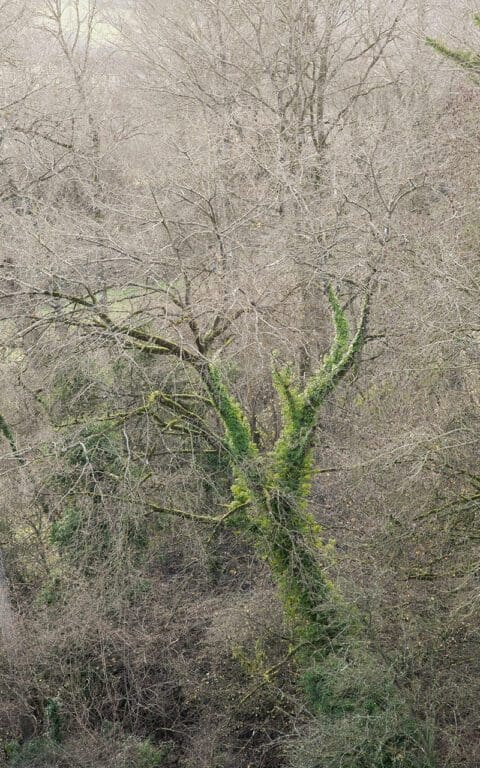

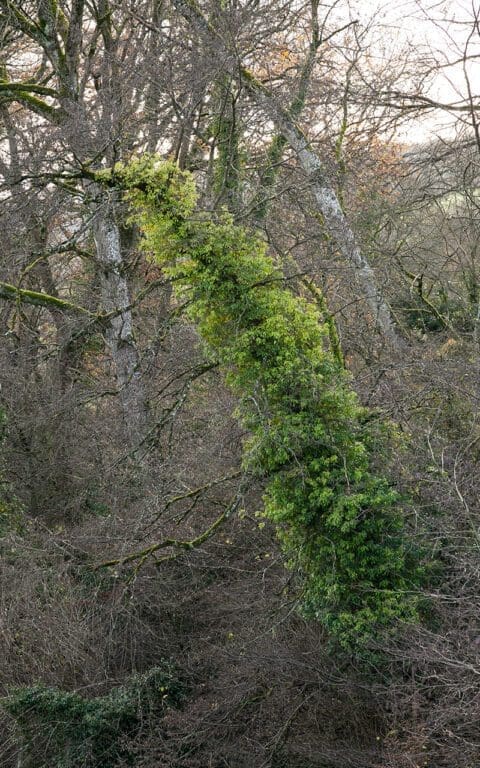
There are mixed feelings about the damage ivy can do. I prefer not to let it loose on buildings for it will forever be in the gutters and having a go at crumbly mortar and window frames, but I am relaxed about it growing into trees. That said, a mature plant can eventually bring a tree down, the weight of foliage providing a sail the host had never allowed for. We have an old hawthorn in the top hedge and at this time of year you can see it is more ivy than tree. Every year after a winter storm I expect it to topple, but I am happy to see the association for now striking a balance and making more of the hawthorn. Walk by it now the foliage is down elsewhere and it is alive with chatter.
Look into the winter hedges and you see that they are also laced throughout with ivy, which in turn provides the hedges with a winter opacity and shelter. The seedlings arrive there from the birds that have gorged upon a mother plant and then paused to poop and this is how they appear in the garden too. Showing you where the perches are and mapping the birds’ movements.
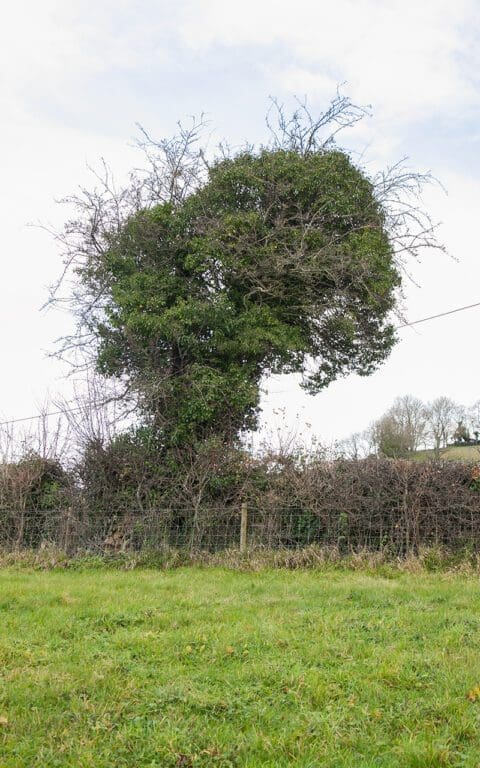
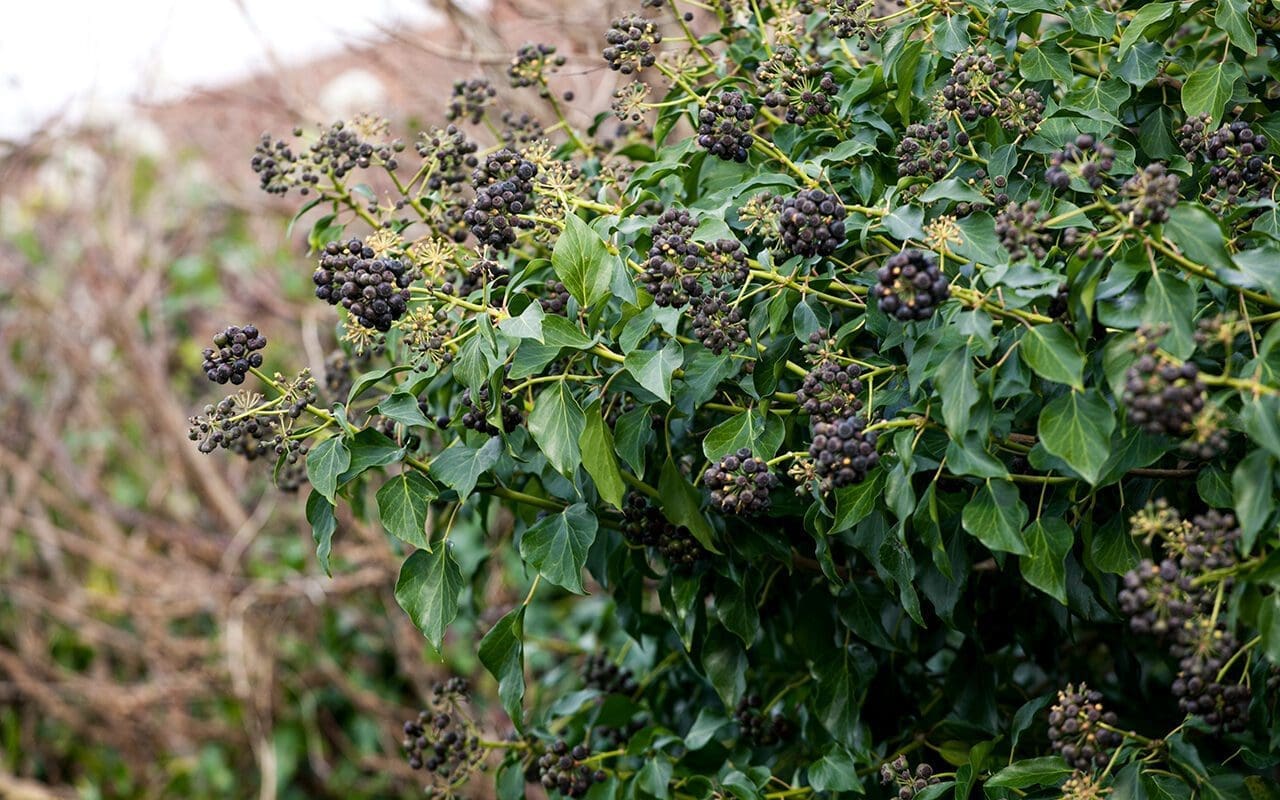
Holly does not do as well here in the hedges as it might on the lighter ground of acidic heathland. I have tried to introduce it, but the plants dwindle and have come to nothing, presumably due to our hearty ground and the advantage it gives to competition. The hollies do better here in isolation and out in the open and we have a pair of old trees by the potting shed that were planted when the land was once a market garden. A neighbour told us that the family who lived and worked here made Christmas wreaths from it for Bath market. Though it is now dwindling, this female tree is a good form, thornless and holding on to her berries for far longer than usual. Not far away in Batheaston a colony of suffragettes who lived in Eagle House planted a collection of hollies each one celebrating a woman who had fought for the cause. An emblem that perhaps also drew upon the ancient appreciation of the constancy provided by this plant and representing, in its winter steadfastness, an image of eternity. We wonder, a little romantically, if our plant might have originally come from the same collection and I have propagated autumn cuttings with the thought that she should have life elsewhere on the land and a new generation.
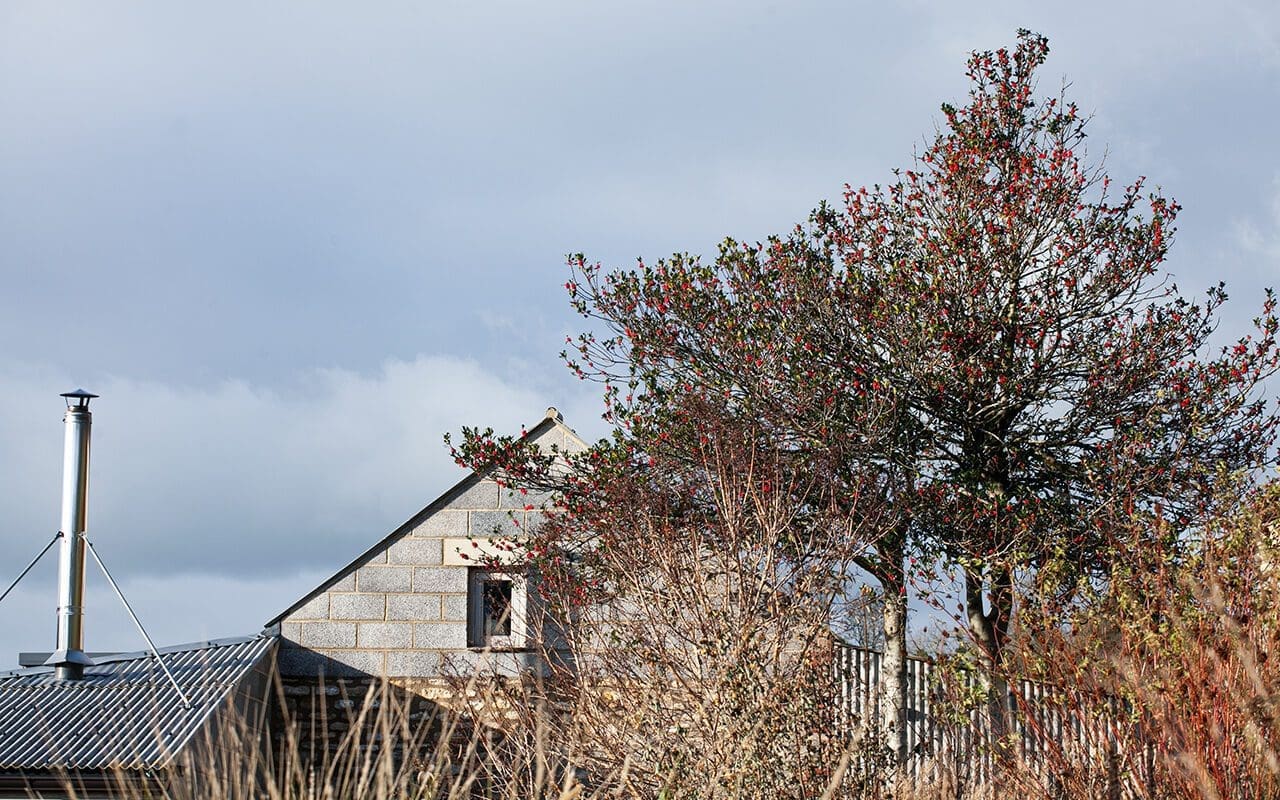
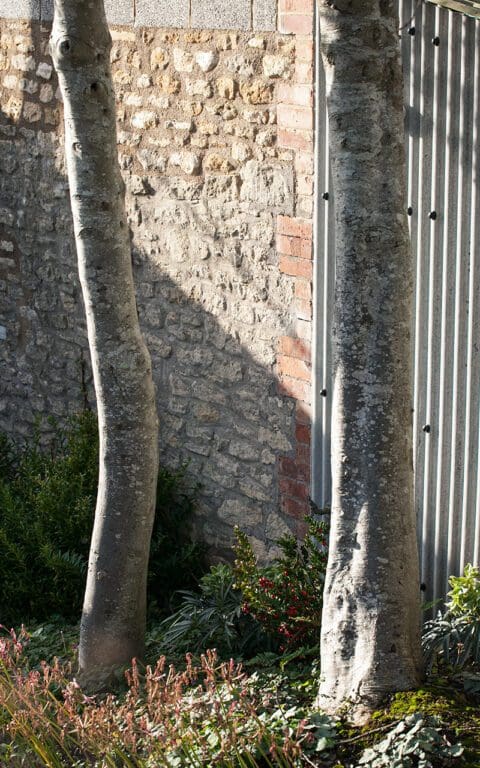
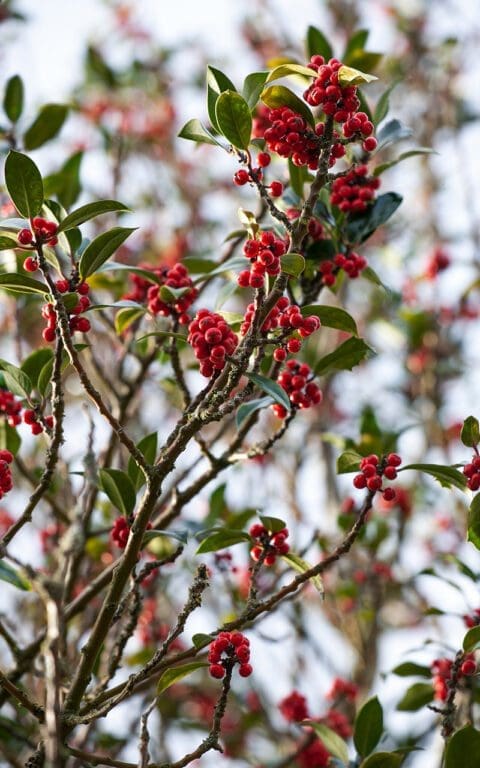
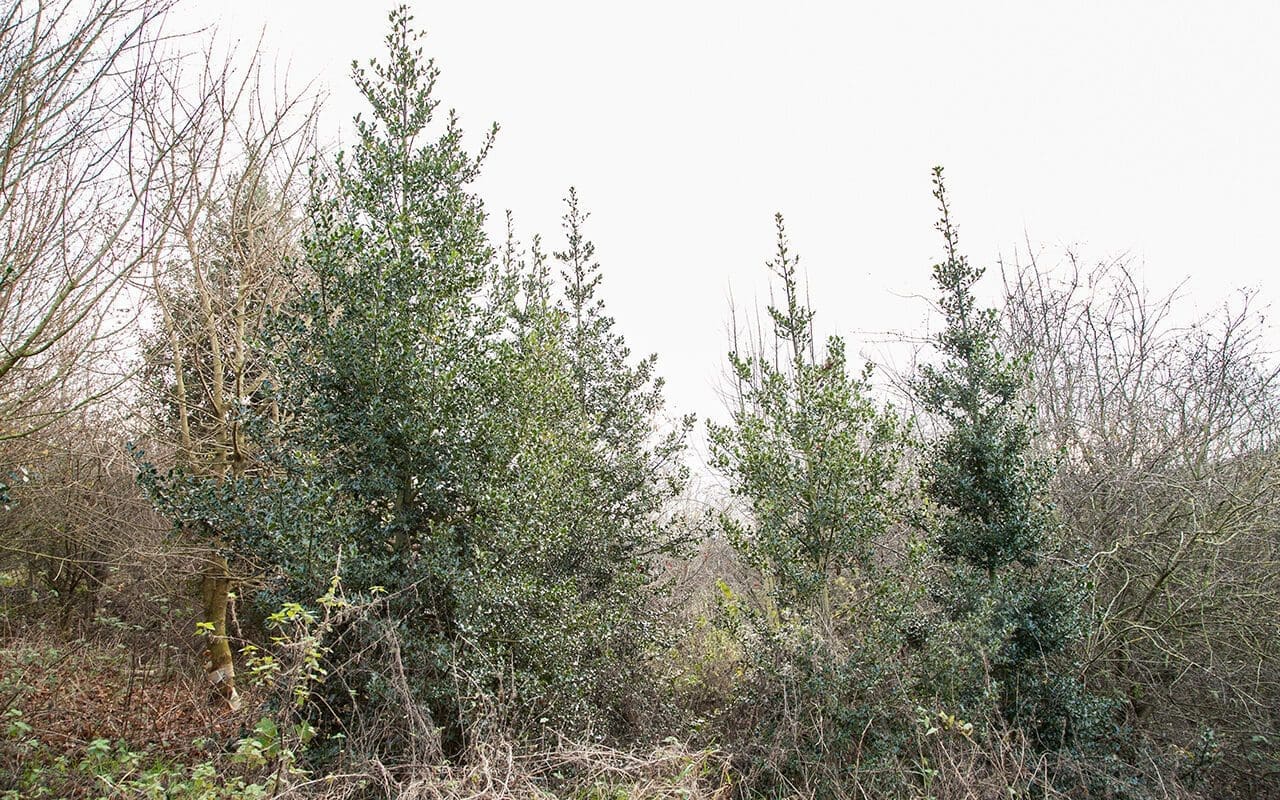
Unless you specifically buy a named female or a self-fertile tree such as ‘J. C. Van Tol’ it is pot luck whether you have bought a female or a male. Though one male can service many trees and from quite some distance when the bees are active, I have planted tens in groups where the sheep cannot get to them. One day, for they are slow, I hope they will provide our land with some weight and heft of winter evergreen.
Just this year, seven years after planting, the females are beginning to fruit. Bright and clean. Red against ink green, foliage shimmering, the leaves as reflective as mirrors when basking in winter sunshine. It is then, in this stark season that you see the holly in another light altogether. Not a tree of darkness and sobriety, but one of light and joyfulness.
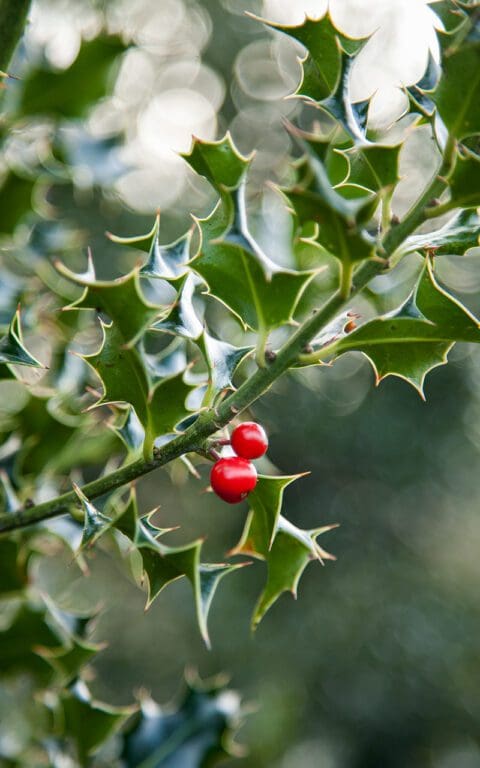
Words: Dan Pearson | Photographs: Huw Morgan
Published 5 December 2020
We are sorry but the page you are looking for does not exist. You could return to the homepage